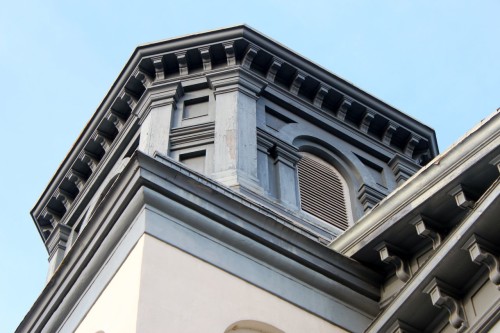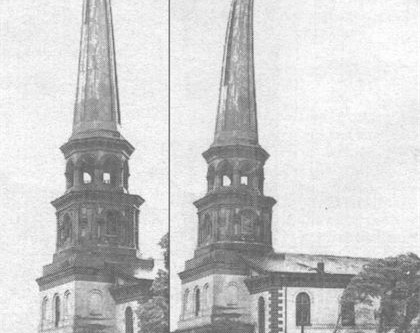Albert West
1860
2000 East Broad St
Today the New Light Baptist congregation calls a compact and august building home, an historic church that stands alone on a block in Shockoe Bottom. As the building’s historical marker notes, the original building served as the Trinity Methodist Church, whose congregation’s meeting at the bottom of Church Hill in 1790 was the founding of Methodism in Richmond. Like many buildings in the city, the original structure was damaged severely by a fire in 1836, but quickly rebuilt.
The most handsome feature of the church is the contrasting color scheme. An understated white body with blue trim accentuates the strong massing of church. Quoining on the front corner, so indicative with Italianate buildings, becomes a key element that sparks just enough visual interest to complement the simple, window-punctured sides. The building announces itself proudly close to the street edge as a thick three-part tower breaks a triangular pediment, defined by multiple cornice lines and topped by an octagonal drum rich with neoclassical detailing.
One of the more peculiar attributes of the building is the absence of its iconic 225 foot spire. Criticized as “a menace to public life” by Richmond’s first building inspector, the wooden tower had apparently sustained too much rotting or weather damage to be safe, yet stayed around for several more decades before removal following Hurricane Hazel in 1954. Albert West, a Richmond-born methodist himself, had a penchant for designing soaring steeples and had a similar tower at present-day Duke University collapse after construction. It was not completely a loss, as the current squat massing of the structure is no less visually awkward than the comically oversized spire. The perimeter also originally contained a handsome cast iron fence.
Despite these changes and other smaller alterations, the building earned a spot on the National Register of Historic Places in 1987 for its architectural beauty and, perhaps more importantly, for its role as a symbol for a developing neighborhood and religion in Richmond’s history.
M.F.A.
Photographs by author.





3 Comments
My father was the minister there during the late 60 early 70s. Rev. Roy Clark.
I am writing my family history. My grandfather, Rev. Roy Clark served as pastor.
I believe the steeple being referenced as a “menace to public life” by the first building inspector was actually the steeple at Broad Street Methodist church, considered a twin to Trinity as it was built by the same architect and had a similar tower to Trinity. The steeple at Broad Street was taken down much earlier than the one at Trinity.
Write a Comment
Posted
Share
Tags
Albert West • Broad St • Church • church hill • italianate • National Register of Historic Places • quoin • spire • steeple • trinityMap